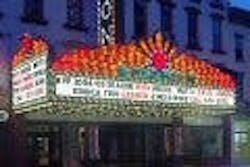LEDs bulbs headline at historic theater in NY state
The Bardavon Theater, located in Poughkeepsie, New York, has hosted entertainment for Hudson River Valley residents for over 130 years. Artists who have treaded the boards include author Mark Twain, crooner Frank Sinatra and dancer Martha Graham. A victim of suburban cineplexes, the Bardavon closed in 1975 and was slated for demolition when local residents rescued the elegant venue.
As part of the renovation project, the Bardavon's original three-sided 1940s era marquee and the vertical blade sign were replaced with replicas that still used incandescent light bulbs as light sources. Later, the 3600 incandescent lamps were replaced with energy-efficient LED bulbs from LEDtronics Inc., a manufacturer of LED lamps based in Torrance, CA.
Following discussions with the LEDtronics' regional representative Jeff Mizel and after testing several sample lamps, Adams purchased 3600 LEDtronics S14-styled, Edison-screw based lamps (part number DEC-S14L-120A) in the colors of white, yellow, orange, red and blue-green. The S14-styled LED lamps feature 25mm Edison-screw bases that enable them to be installed into existing sockets without requiring pricey modifications.
Less juice
The marquee and the blade sign typically operate for 6-8 hours per show about 150 times a year, which averages about 3 hours a night over the course of a year. Due to the use of chaser circuits all the lamps are never lit simultaneously, but even so the 11W S14 incandescent lamps consumed 38 kW. At 3 hours per night (118 kWh) at an average cost of $0.08 per kWh, the total cost was around $9.44 per day or $3445 per year.
LED lamps drastically cut the amount of energy consumed from 38 kW to 4.68 kW, since the 3600 LED lamps each draw 1.3 W. At $0.08/kWh, the annual electricity cost for the LED lamps is about $124.40. That adds up to an annual saving of $3203 a year, nearly $9609 over the three-year warranty period, and $35,233 over the typical 100,000-hour LED operating life. The annual energy saved is 38,237 kWh.
Other benefits
Besides lower energy costs, the Bardavon has benefited from the installation of the LED lamps in another substantial way - less maintenance. In the two years since the theater's signs were reconstructed the Bardavon had only replaced about 50 of the 3600 incandescent bulbs, but the theater's maintenance staff was not looking forward to the inevitable day when batches of incandescent bulbs would have to be changed.
When it comes to choosing lights for outside applications like the theater's signs, it's hard to best LED lamps. Sealed assemblies make LED lamps able to take the punishment of seasonal weather. Impervious exteriors safeguard the electronics from water while the hardy polycarbonate globes protect the LEDs from incidental impact and the deteriorating effect of the sun's UV rays.
Solid-state devices withstand the electrical stress from the use of chaser circuits. Each time an incandescent lamp is turned on the filament within the glass globe weakens and eventually breaks. LEDs don't have filaments to break. Their solid-state electronics enables LED bulbs to be turned on and off any number of times without worry of burnout. What's more, LED cluster lamps continue to provide light even if one or more individual emitters fail.
The power and maintenance savings meant that the LEDs paid for themselves in no time at all. Reducing energy and maintenance expenses freed up resources for the theater's other restoration projects. LED lamps helped the theater achieve its goals of reducing energy consumption, avoiding future maintenance expenditures and updating the theater's façade.
